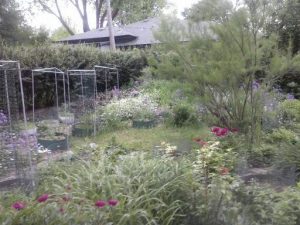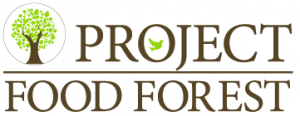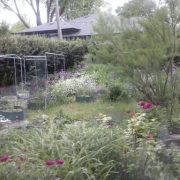Hiding in Plain Sight
Having a chemical free garden means not using pesticides. So, if I’m not using pesticides, how do I keep the bugs from eating the vegetables? Well, there are two strategies that are closely related. One is to encourage good bugs that eat the bad bugs to come and live in my garden. The other is to hide the veggies so that it is harder for the bugs to find them. Both strategies depend on flowers.
Flowers, especially native ones, provide food and shelter for various predatory insects that help control destructive insects. A quick on-line search provides a long list of plants that support beneficial insects. I’m happy to say that I have a number of those in my garden. Native plants have the edge in this area because they have had millions of years to form relationships with the local good guys.
I noticed the difference between native and non-native plants in supporting the local good guys one day while I was sitting on my patio under the big Linden tree. The hostas (non-native) were in bloom and one lonely bumblebee stopped by to check them out. Meanwhile, on the other side of the garden, the milkweed (native) was in bloom. It was buzzing (literally) with activity. There were bumblebees, honey bees, blue mason bees, flies of various types and an occasional wasp. And more importantly, milkweed provides food and habitat for Monarch butterflies. So the milkweed was pulling its weight for the ecosystem. The hosta – not so much.
Beneficial insects need places to live and lay their eggs so they are ready to go when bad bugs arrive. For instance, I was tested when aphids attacked my rose bush shortly after I decided to go chemical-free. I still had some rose dust in the garage I could have used but I decided to see what happened. A couple of days later the bush was covered with lady bugs who ate the aphids. The lady bugs were hanging out somewhere nearby just waiting for a meal. That was about twenty years ago. Today, the rose bush is doing fine.
 Part two of my chemical-free pest control strategy involves putting the vegetables right in with the flowers and native plants. I made round raised beds that are 30” in diameter (I will tell how I came up with the idea in a future post). I plopped these down along the paths I made through my flower garden. The vegetables planted in the raised beds are surrounded by flowers. This hides the vegetables both visually and probably by scent as well from the bad bugs. So, my vegetables hide in plain site and suffer little damage from bugs.
Part two of my chemical-free pest control strategy involves putting the vegetables right in with the flowers and native plants. I made round raised beds that are 30” in diameter (I will tell how I came up with the idea in a future post). I plopped these down along the paths I made through my flower garden. The vegetables planted in the raised beds are surrounded by flowers. This hides the vegetables both visually and probably by scent as well from the bad bugs. So, my vegetables hide in plain site and suffer little damage from bugs.
Post by Boyd McPeek – Board Member, At Large




Hi Boyd, I like this clever hiding right before your eyes strategy. I was surprised when you said that your aphid/ ladybug test was 20 years ago – that’s a solid bit of evidence that your “experiment” is working. And your garden looks beautiful!